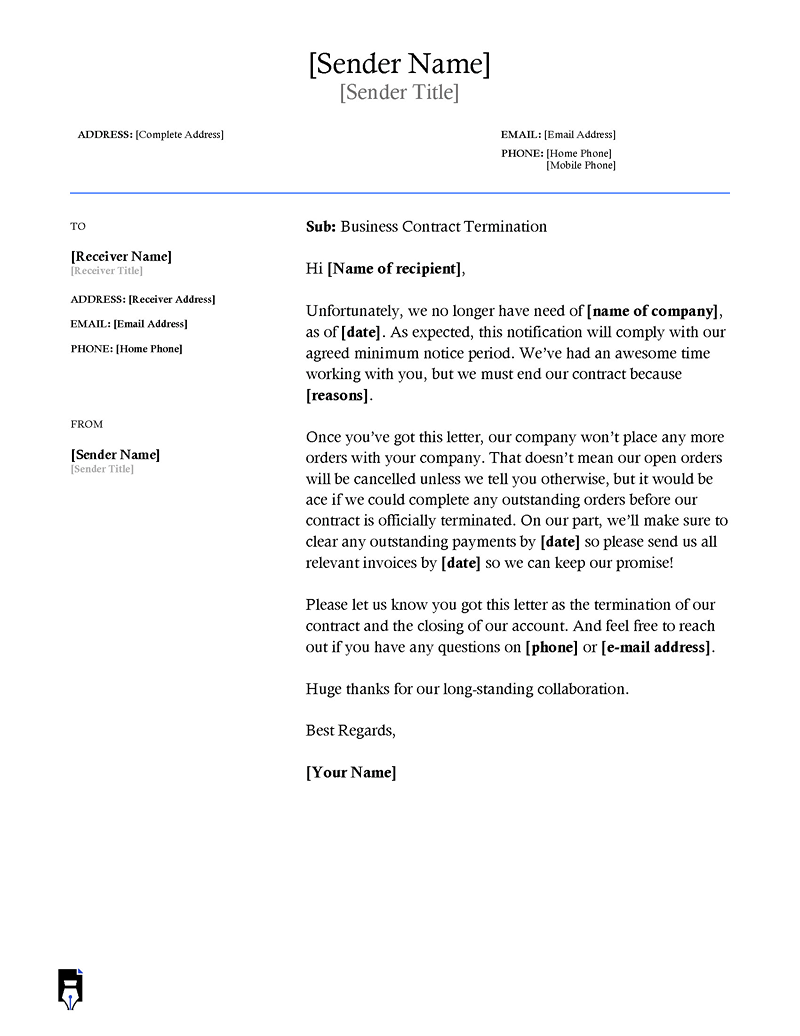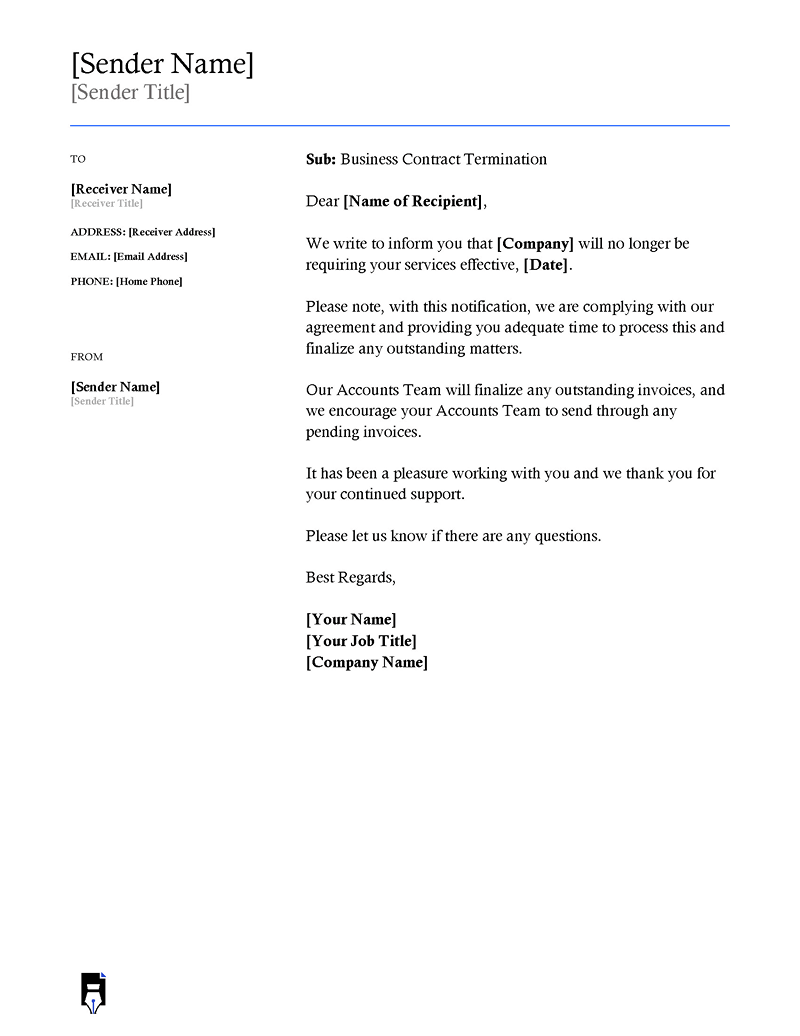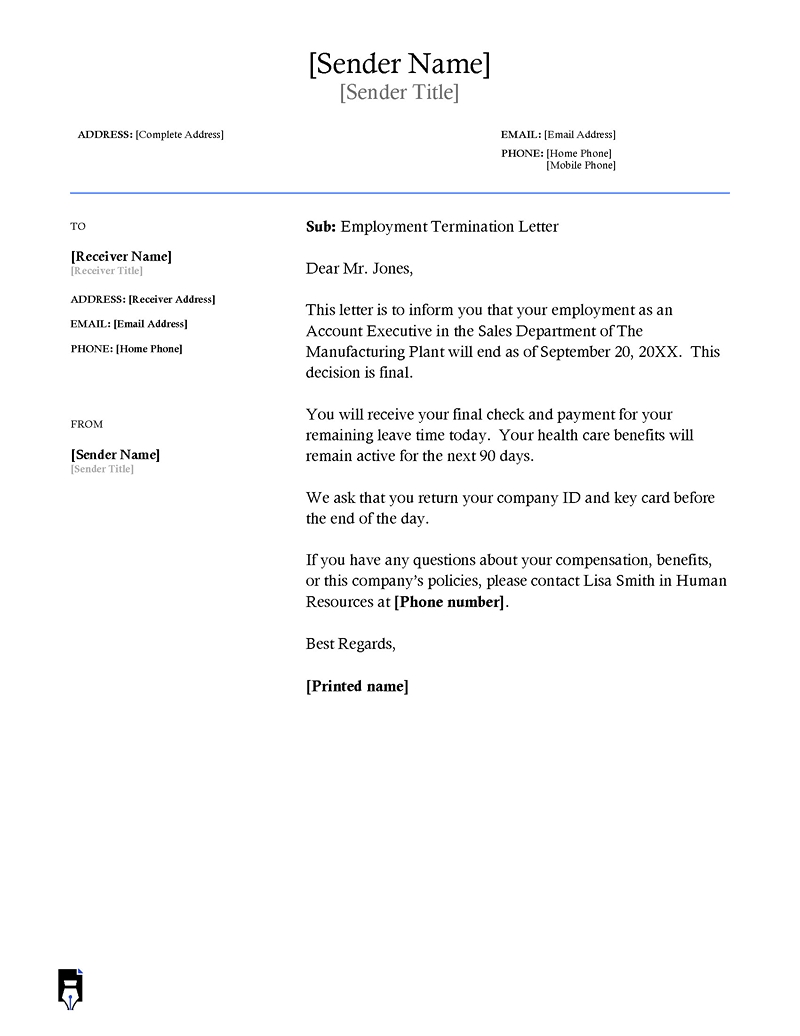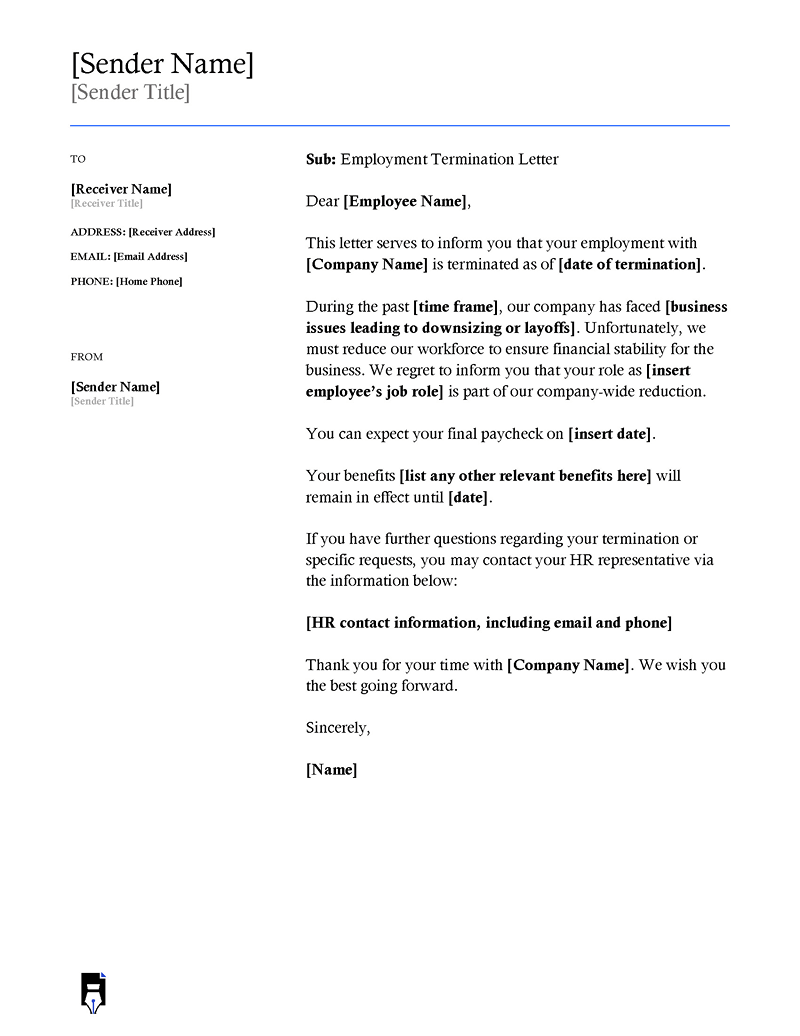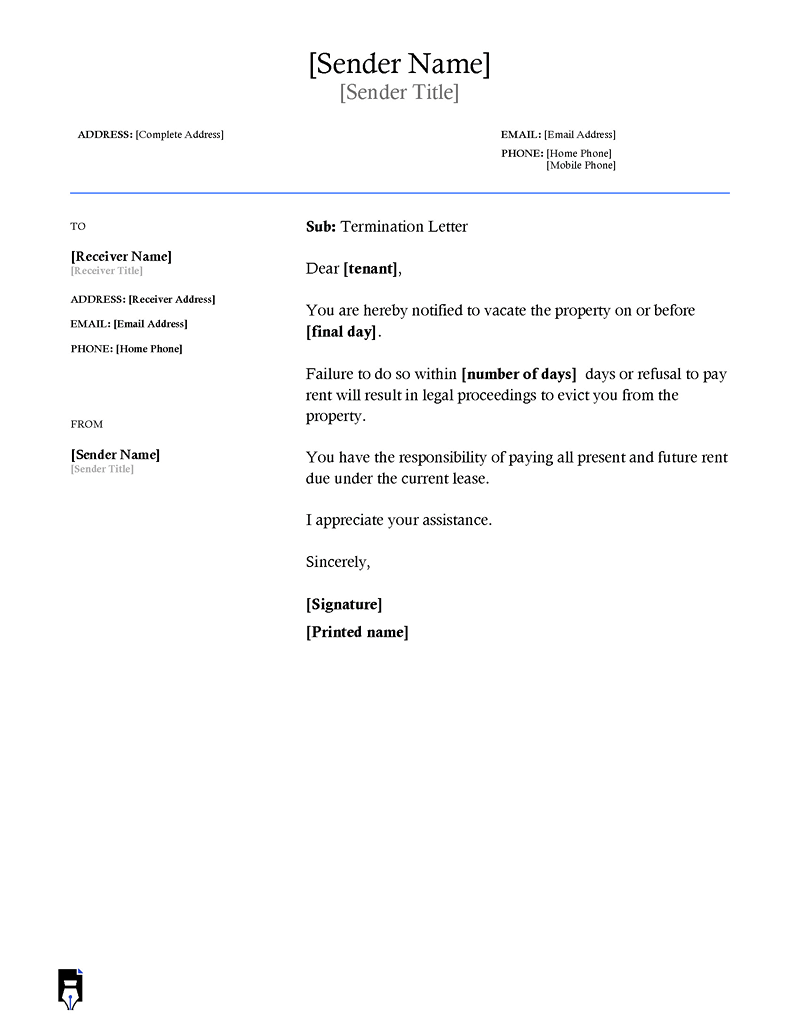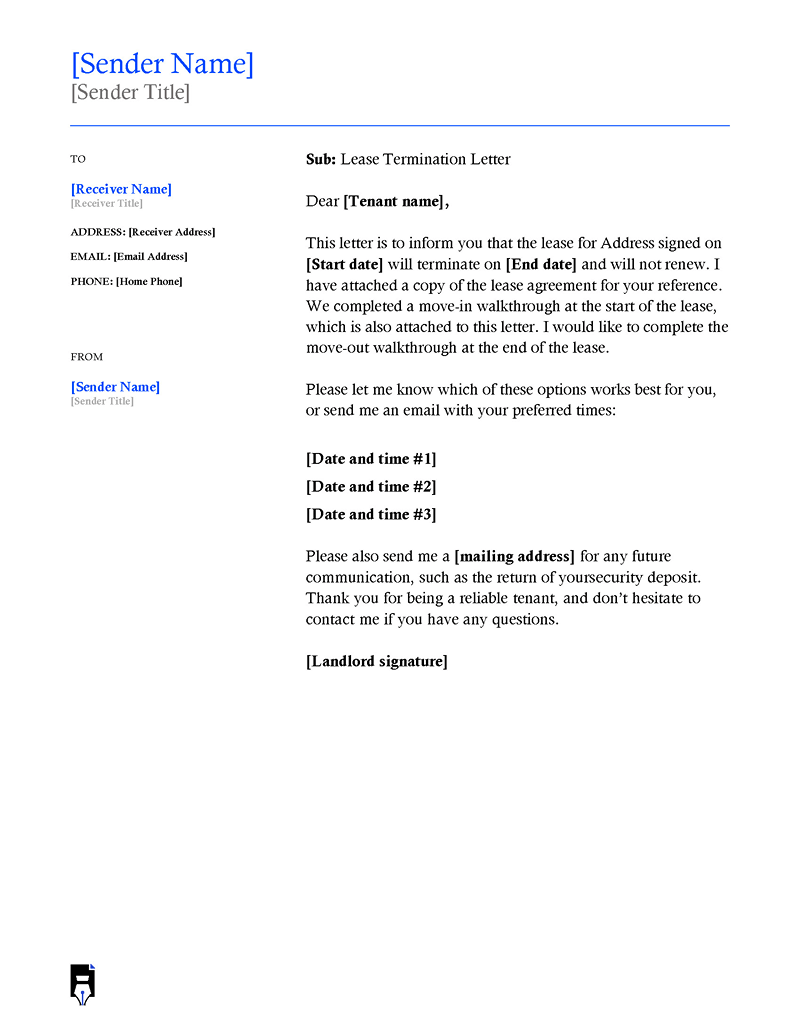A termination letter is a formal communication informing an individual or party that a business relationship, employment, contract, or agreement is being terminated.
This letter can be written when dismissing an employee, canceling a lease, terminating an insurance policy, or ending a business contract between a client and contractor. It indicates why the agreement is being terminated, its effective date, the obligations of both parties and instructions on the subsequent steps to end the agreement.
These letters notify the other party of the decision to end an existing relationship. Depending on the circumstances, contracting parties might be required by law to give the other party prior notice before terminating a contract. For example, employers and landlords are often required to give official notice before dismissing an employee or terminating a lease contract, respectively. Businesses also have to end contracts with vendors in writing. The letter must be accurate and truthful, as it is considered a legal document that can be referred to in legal disputes.
Free Templates
Given below are business contract termination letter templates:
This article explains termination letters, how to format them, and their basic structure. It also provides a sample letter to illustrate how agreements can be terminated.
Who Can Write a Termination Letter?
Termination letters can be written by various individuals or entities, depending on the context of the termination. In the case of terminating employment, the termination letter is typically written by the employer or the human resources department representing the employer. For a rental agreement, either the landlord or the tenant can write the letter, depending on who wants to end the lease prematurely or does not want to renew it. The same would apply to service arrangements or contracts; either party (the contractor or client) can end the relationship. In a business partnership, either of the partners or a legal representative can write the termination letter.
Format of a Letter of Termination
The information contained in a letter of termination will vary depending on the situation. An employment dismissal letter will be different from a lease termination notice. Some letters will be more detailed than others. However, the format of the letter will typically be consistent across the different applications.
The basic elements to include are as follows:
Date
A date is needed for reference and filing purposes. It should be noted that the document will usually be stored with other official records. So, a date is needed to ensure the letter can be located whenever needed. Make sure that the date illustrates the day, month, and year.
Addressee
Letters should be addressed to the person or party for whom they are intended. If there are more than one recipient, make sure to address each one separately. Use the correct contact information, such as a street address, city name, state, ZIP code, etc., to specify who is being addressed.
Salutation
A formal salutation is needed in all formal documentation, including a letter of termination. Use the following format – Dear+First name+Last name.
Opening paragraph
In the opening paragraph, specify the purpose of the letter, which is to terminate the business relationship, rental or lease agreement, employment, contract, or agreement. Briefly include the reason for the termination.
Details
In the body of the letter, provide details about the termination, such as the effective date and any outstanding obligations or instructions. Examples of subsequent steps include the return of company property, the collection of severance packages, or compensation. Also, reference specific incidents that resulted in the cancellation of the contract. For example, a landlord can list any lease violations that the tenant has committed. This section is important in justifying the termination.
Appreciation
Despite the premature end of the contract, agreement, or relationship, concluding it on a positive note is important. Showing appreciation in a termination letter can help preserve relationships, particularly in situations where there may be future interactions or potential opportunities for collaboration. It demonstrates goodwill and leaves a positive impression, which may be beneficial in future endeavors.
Closing
Urge the recipient to make contact if they have inquiries regarding the dismissal or cancellation. Mention the appropriate person who needs to be contacted and their information. Also, include a complimentary close, such as Sincerely and Best Regards. A formal closing is always used in formal correspondence.
Signature
The sender or authorized party must sign the letter. The name and title of the signatory should be specified. A signature is attached as a formal acknowledgment of the letter’s contents.
Termination Letter Template
______________ [Business Letterhead or sender’s contact information]
_____________ [Date]
_____________ [Recipient’s Name]
_______________ [Recipient’s Address]
Dear _____________ [Recipient Name],
This is a formal notice of termination of the _____________ [Contract/arrangement or relationship] between ____________ [sender] and ________________ [recipient], which was signed on [date]. The termination takes effect from ________________ [effective date]. We have reached this decision due to ______________________ [specify the reason for the dismissal].
After thoroughly reviewing your case file, we are confident that ending our relationship is the best step for our business. It is evident that you have consistently __________________ [specify contract violation or wrongdoing] that violates the agreement. We intend to fulfill our contractual obligations as per the contract. We also expect you to ______________________ [enlist the next steps].
We appreciate the relationship we have built over the course of our interaction and are saddened to be inevitably parting ways. We wish you prosperity moving forward. Please sign and return a copy of this letter to acknowledge your receipt and understanding of the termination. If you have any questions or require further clarification, please do not hesitate to contact me at [Your Email Address] or [Your Phone Number].
Sincerely,
_____________ [Sender’s Name]
______________ [Sender’s job title]
Types of Termination Letters
As discussed earlier, termination notices have multiple commercial applications. So, it is important to understand how they vary in different circumstances.
Below are the different types of terminations that can be done through such letters:
Employee dismissal letter
Employers should ideally dismiss employees in writing through a notice of dismissal. This letter must state the purpose of the termination, the employee’s last day of work, and the date of the final paycheck. Such a notice should be sent after other means of intervention, such as informal and in-person contact and warning notices, have been sought. The notice must also comply with applicable labor laws and company policies. Human resources or the employer often craft such letters.
Statistical insights: 75% of employers use written correspondence to fire employees, according to the Society for Human Resource Management (SHRM). Also, according to a survey conducted by the Employment Law Alliance, wrongful termination lawsuits have increased by 260% in the last two decades.
Notice of lease termination
Landlords and tenants will typically terminate leases through letters. Either party can cancel a lease agreement. Some reasons for ending a lease are failure to pay rent, inhabitable premises, breach of contract, employment termination of the tenant, etc. This notice must be sent in accordance with the procedure outlined in the lease agreement. Landlords and tenants normally have a standard notice period of 30 days to notify the other party. Landlords must justify the termination, as the wrongful ending of the lease may be considered unlawful eviction, which is punishable in most jurisdictions.
Additionally, if the lease is terminated prior to the end date, tenants must be ready to take responsibility for the resulting consequences, which may include forfeiting their security deposit, particularly if the proper procedure is not followed.
Did you know? 90% of tenants who are issued a lease termination notice due to nonpayment of rent eventually vacate the leased property, according to the Apartment Owners Association of California.
Insurance termination letter
Policyholders often cancel an insurance policy due to high insurance rates, relocation, unsatisfactory services, or business changes requiring new insurance coverage. A letter to cancel an insurance policy should specify the policyholder’s and insurer’s names and contact details. It must also indicate the policy number, coverage period, and effective date of termination.
Volunteer termination letter
Since voluntary services are offered without compensation, a letter terminating a volunteer should be written differently from one issued to an employee. It is written in an appreciative tone and focuses on the volunteer’s positives. It can discuss their noteworthy contributions. However, it must indicate the reason for ending the contract. This can be a regulation, moral, or ethical violation. This type of letter should be characterized by courtesy, formality, gratitude, suggestions or recommendations, and instructions on how volunteers can improve.
Vendor termination letter
Business owners should notify vendors that they no longer require their services. The letter must state the effective date of termination and be sent with sufficient notice to give the vendor enough time to complete any contractual obligations. It can also mention the terms and conditions that were violated, if any. Examples of reasons why such contracts can be prematurely ended include fraud, breach of contract, unsatisfactory performance, and a change in business needs.
The letter should also outline the termination process, including the effective date of termination and any necessary actions or obligations the vendor needs to fulfill. This may include returning any company property, resolving outstanding financial matters, or transitioning ongoing projects or services to another vendor. Clearly communicate any timelines or deadlines for these actions to ensure a smooth and orderly termination.
Notice of business contract termination
Businesses will have multiple agreements at any given time. These include leases, partnerships, contracts with clients, agencies and local authorities, etc. Terminating such a contract can result in severe legal consequences. Therefore, the notice of termination must be in writing. It should explicitly indicate the reason for the cancellation and the steps to be taken to properly conclude the relationship, like inviting the other party for a more in-depth discussion on the matter. The document must be written in a professional format.
Things to Avoid When Writing a Termination Letter
A letter of termination is a legal document in most cases. So, attention must be paid when writing it. Employers, landlords, tenants, and businesses should avoid the following things that can reduce its effectiveness.
Using vague language
Avoid using ambiguous language or euphemisms that may confuse or mislead the recipient of the letter. The recipient must understand the details of the premature ending of the contract.
Using emotional language
Be objective in your communication. Do not use emotional language or statements that could be interpreted as discriminatory or offensive. Remember that the notice can be admissible evidence in legal proceedings.
Providing incomplete information
The letter is a formal and legal document. So, avoid using incomplete or inaccurate information that could lead to misinterpretations and misunderstandings.
Delaying sending the letter
Do not delay sending the letter. Once the decision to end the contract has been made, send the notice and give the other party ample time to make arrangements and fulfill their contractual obligations.
Giving false reasons for termination
Do not give false reasons for termination. Wrongful terminations can result in litigation. Review applicable laws such as tenancy laws, labor regulations, and existing contracts to verify if the existing reasons are valid. Also, consult legal counsel where necessary.
Key Takeaways
- Termination letters serve as documented evidence of the termination, ensuring that both parties are aware of the decision and its reasons. This can be crucial in case of any future legal disputes or claims.
- While the specifics of a notice ending an agreement vary from case to case, it is important to understand the basic elements of such a letter. These elements include the parties’ details, statement of intent to terminate, effective date, supporting details, closing, and signature.
- Letters of termination are admissible in court as evidence, so always review and consult applicable contracts, laws, and regulations before sending one.
- The person writing the letter must have the authority to end the respective contract or business relationship.
